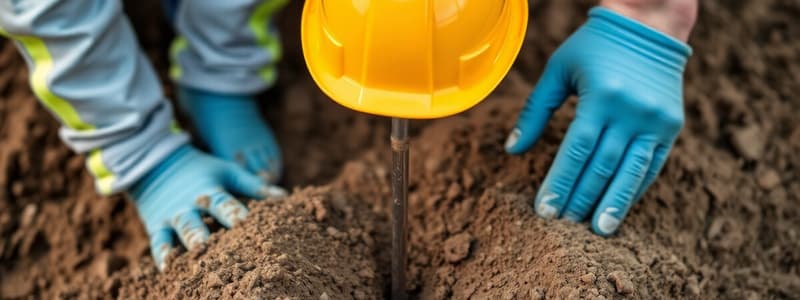Podcast
Questions and Answers
What is the primary advantage of using test pits for shallow soil exploration?
What is the primary advantage of using test pits for shallow soil exploration?
- They are the most advanced and complicated method of testing.
- They can reach up to 100m in depth.
- They allow for visual examination of in-situ soil conditions. (correct)
- They provide continuous soil samples from deeper strata.
Which method of soil sampling is considered the most widely used?
Which method of soil sampling is considered the most widely used?
- Test pits
- Geophysical methods
- Soil boring (correct)
- Laboratory tests
What technique is associated with wash boring?
What technique is associated with wash boring?
- Chopping and jetting action of drilling fluid. (correct)
- Creating a continuous core sample.
- Pulling soil samples using suction.
- Filling the hole with cement after testing.
In which type of soil is percussion drilling least effective?
In which type of soil is percussion drilling least effective?
Which of the following statements about auger boring is false?
Which of the following statements about auger boring is false?
What is the point resistance range for very loose soil?
What is the point resistance range for very loose soil?
In the Standard Penetration Test (SPT), what is the weight of the falling mass used to drive the sampler?
In the Standard Penetration Test (SPT), what is the weight of the falling mass used to drive the sampler?
What is the approximate relationship between the angle of internal friction (ϕ) and relative density (Dr) for granular soil containing more than 5% fine sand and silt?
What is the approximate relationship between the angle of internal friction (ϕ) and relative density (Dr) for granular soil containing more than 5% fine sand and silt?
What is the consistency classification for a soil with an unconfined compressive strength of 55 kN/m2?
What is the consistency classification for a soil with an unconfined compressive strength of 55 kN/m2?
How is the standard penetration number (N) affected by soil density according to Terzaghi and Peck?
How is the standard penetration number (N) affected by soil density according to Terzaghi and Peck?
Flashcards are hidden until you start studying
Study Notes
Methods of Sub-Surface Investigation
- Various techniques available: test pits, boring and sampling, field tests, geophysical methods, and laboratory tests.
Test Pits
- Simplest and most cost-effective for shallow soil exploration (3-4 meters depth).
- Facilitates visual examination of in-situ soil conditions.
- Allows easy collection of disturbed or undisturbed soil samples.
Soil Boring and Sampling
- Most widely used method for obtaining soil samples at varying depths.
- Includes multiple methods: auger boring, wash boring, percussion drilling, and rotary drilling.
Auger Boring
- Can be operated manually or powered.
- Hand-operated augers (15-20 cm diameter) come in types like post-hole and helical.
- Provides highly disturbed samples; power augers can reach depths of 30m in many soil types above the water table.
Wash Boring
- Utilizes a power-operated system with a chopping bit and drilling fluid (usually water).
- Suitable for sandy and clayey soils but not for very hard materials like boulders.
- Penetration depth can exceed 60m; identifies soil strata changes through sound and slurry examination.
Percussion Drilling
- Power-operated, it progresses by delivering repeated blows from a heavy chisel.
- The resulting slurry at the borehole bottom is removed with a bailer or sand pump.
Dynamic Penetration Tests
- Standard Penetration Test (SPT):
- Measures soil resistance to dynamic penetration using a split spoon sampler.
- Driven by a 63.5 kg mass dropped from a height of 76 cm, initial and subsequent driving are recorded for standard penetration value (N).
Correlation of Penetration Data
- Relationship between N (number of blows) and various soil properties, such as relative density and unconfined compressive strength.
- Meyerhof's equation relates density and cone resistance, which can estimate compressibility for sand.
Vane Shear Test
- Measures undrained shear strength of soft clays using a steel rod with stainless steel bladed vanes.
- Torque applied to shear the soil, with maximum torque indicating shear strength.
Plate Loading Test
- Involves applying static load on a steel plate to assess soil settlement.
- Procedure includes proper plate positioning and controlled loading to measure bearing pressure against settlement.
- Limitations include short duration tests not capturing full consolidation behavior under certain soil conditions.
Pile Loading Test
- Most reliable for ascertaining pile load capacity.
- Testing closely resembles the plate-loading test, providing data on allowable bearing capacity and load-settlement relationships.
Geophysical Methods
- Effective for identifying strata locations and quick evaluations of sub-soil characteristics.
- Broadly categorized into seismic refraction and electrical resistivity methods.
Soil Exploration Report
- Typically includes: purpose of investigation, site description, geology, detailed findings from tests, lab results, discussion related to foundation design, and conclusions with recommendations for foundation types and allowable bearing pressures.
Studying That Suits You
Use AI to generate personalized quizzes and flashcards to suit your learning preferences.




